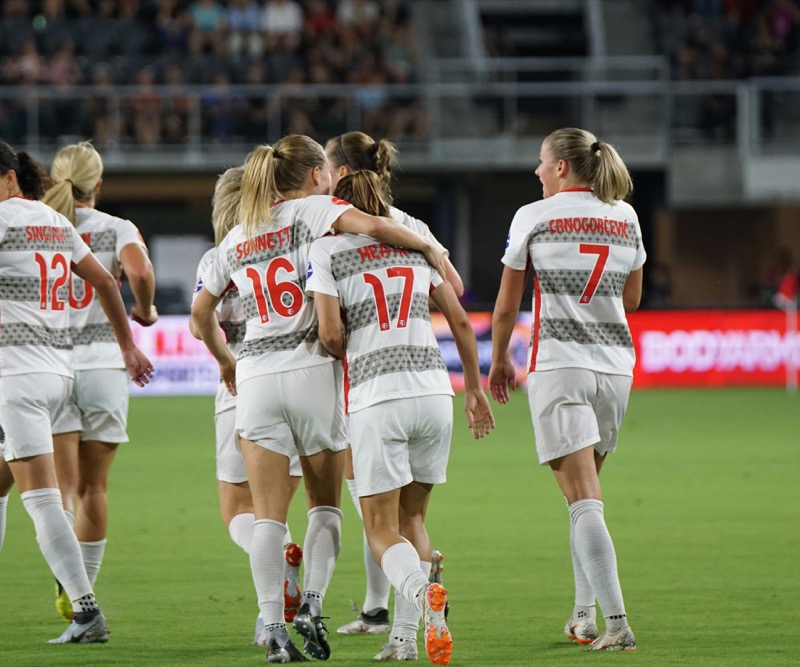Want to read in Dutch? Click here
Recent research has shown that the majority of female athletes are hindered by their clothing. It doesn’t fit well, and they feel uncomfortable in it, which affects their performance on the field. The solution is simple, but the sports world seems to be hindering it. What’s going on here and how can this problem be solved? The researchers have an idea…

Women’s clothing is uncomfortable
In recent years, issues with sports clothing for women have been a topic of discussion. Especially the white shorts often worn during matches are a sore point for many. In 2022 and 2023, several women’s football teams have already indicated that this clothing feels uncomfortable during menstruation. Tennis players at Wimbledon have also complained about it, leading to the mandatory white clothing being abolished.
But the problem is not limited to the color of the clothing. Therefore, researchers at Victoria University in Australia conducted a survey of 286 female athletes. The women ranged in age from 15 to 80, with 33-year-olds forming the average age. Of the group, 250 women were competing at a professional level.
It’s striking that 61% of the women for whom sports is their profession feel uncomfortable in the clothing they have to wear. Among those who pursued sports as a hobby, this figure was even 67%. And 82% of the total group would feel more comfortable if they could choose their own clothing.
Research shows that women’s clothing hinders sports careers
To pinpoint exactly where things go wrong, the study also examined what was missing in the clothing. It turns out that the fit is especially poor. The clothing doesn’t fit well and is often not designed for women. Female athletes had to wear unisex clothing, which, as we now know, is made for the male body.
The lack of choices is also found to be bothersome. Sizes are often limited, making it unlikely that the clothing will fit well. Additionally, consideration is not always given to the seasons, so in winter, sports may have to be done in shorts and short sleeves. As has been shown in recent years, this research also indicates that women are not enthusiastic about white clothing.
Fortunately, not only the problem was examined but also potential solutions. The athletes know exactly what they want. To make the clothing more comfortable, it should be designed for the female body without being too tight or revealing. A stretch fabric and an elastic waistband are also mentioned as solutions.
Regarding freedom of choice, a layered system seems to be the answer. If there’s a choice between long-sleeved shirts, polo shirts, trousers, jackets, and leggings, it becomes more enjoyable to exercise in different weather conditions.
Solutions are within reach
This all sounds very simple. Why hasn’t the problem been solved long ago then? The unisex clothing already gives a bit of a clue. It’s a world dominated by men. That’s why women also receive clothing designed for men. Not enough thought is given to the fact that they need a different fit.
In the report, the researchers point to sports clothing manufacturers. They believe that insights should be shared with them so that they can make better clothing. I don’t find this a strong conclusion. Manufacturers produce what there is demand for. It’s as simple as that. You also see this with functional work clothing. If the makers of this clothing don’t hear that a female fit is important to the customer, then it won’t be made. That also explains why some companies only sell men’s clothing. They don’t receive enough requests to adapt the collection. Fortunately, women are increasingly speaking out about poor work clothing, leading to the growth of the women’s workwear market.
It’s actually a chicken-and-egg story. Manufacturers want to make money and therefore respond to market demand. But the market needs to ask this question and not pretend it’s not there. Just look at the anti-leakage shorts Nike made for the World Cup. They received messages and listened to them.
In that regard, I think the sports world should take responsibility. Speak up and say what the problem is. You don’t need to educate manufacturers with research results. They know how to make clothing. Make sure women speak out and are heard. That’s ultimately the most important thing. Solutions will follow naturally.
Best regards,
Aileen
